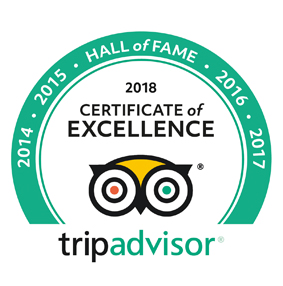Gokyo Lakes Trek offers a fascinating experience taking you through beautiful landscapes of the Everest Region. The trek provides the majestic view of Gokyo lakes and the surrounding. You will walk along the scenic valley, and explore the rich Sherpa culture during the trek.
The Gokyo Lake Trek is immensely rewarding. Choosing the most ideal season for the Gokyo Lake Trek is a must since weather plays an important role in determining the accessibility, views and overall trekking experience. Each season presents different trail conditions and views.
Knowing what every season is like will help you to make a well-informed choice. You can choose the right time for Gokyo Lakes Trek by comparing the pros and cons of every season
The spring and autumn seasons are the best times for the Gokyo Lake Trek. The mild temperatures and favorable trails during these months offer delightful navigation experiences. The stable weather and clear views of the mountains are major attractions of these seasons
The journey in these peak seasons rewards you with mesmerizing scenery of the snowy peaks such as Everest, Cho Oyu, Makalu and many others. Trekking during these periods ensures a fulfilling journey. You can immerse yourself in the magic of the Himalayas by selecting the right time for trekking.
Best Time to Trek Gokyo Lake
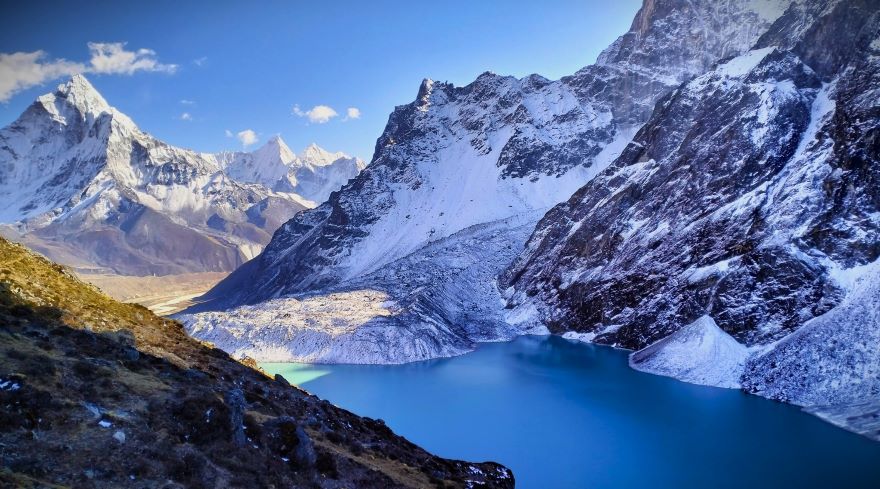
Spring (March–May)
Spring is one of the best times to trek to Gokyo Lake. This vibrant season transforms the trails of the Khumbu Region into a blooming paradise. The rhododendrons and other Himalayan wildflowers in the forested area and hillsides decorate the landscape and present the awe-inspiring scenery. The colorful flora adds extra magic and charm to the beautiful Himalayan landscapes. In addition, the clear blue spring skies and pristine air provide unequaled vistas of the towering snowy peaks.
The temperatures in the spring months are comfortable. The temperature varies from mild to warm in the day to cool at night. So, it is considered the ideal trekking weather. With fewer chances of heavy downpours and snowfall, the trails are dry and conditions are favorable for trekking. It is among the best trekking seasons in Nepal, and teahouses along the route can be packed. So, reserving a trek package or accommodation in advance is advisable.
In the spring season, you can have a rare opportunity to witness the majesty of the Himalayas, when the atmosphere is most lively. The Himalayan flora and the earthy aroma during this season reward you with a refreshing atmosphere. The temperature at the lower region during the spring months ranges from 10°C to 16°C during the day time. In the nighttime, the temperature generally drops up to –5 °C.
March comes right after the winter, so in early days there may be some snow at higher zones. So, you need to be prepared to pack sturdy footwear and warm clothes. May marks the transition from spring to monsoon. So, there is a chance of pre-monsoon rain, especially in later days. So, carry a set of rain gear to stay dry and warm. Being well-prepared rewards you with a safe and enriching trekking experience in the spring.
Autumn (September–November)
Autumn season is also among the most preferred times for Gokyo Lakes Trek. This season presents the alluring panorama of the enchanting mountains. At this period of the year, you can have a unique chance to witness the awe inspiring beauty of mountains and lakes. The crisp and dry weather conditions of autumn presents outstanding visibility. So, you can see the towering summits and tranquil Gokyo Lakes without any obstructions.
In autumn months, the picturesque landscapes are dry, and you can ensure a more enjoyable trekking experience. In addition, the more moderate temperatures reward you with a comfortable journey without any concerns of the heavy rains or snow showers blocking the trail and interrupting the journey.
The daytime temperatures during the autumn months typically range between 12°C and 20 °C. The nighttime temperatures can drop up to -8°C. The vivid views and favourable trekking climate make autumn the perfect season to marvel at the beauty of nature.
Autumn is also a great time to visit because of the cultural exploration opportunities. Mani Rimdu, the vibrant festival which is celebrated annually is usually celebrated in the autumn months in October and November. Getting an opportunity to celebrate it together with locals is truly unique and fascinating.
During the early days of September, there will be light rainfalls. So, you need to pack rain jackets and pants. As the season progresses, the signs of winter can be felt, especially during the late days of November. The temperatures in higher areas drop below freezing. Thus, being prepared for colder conditions is essential by packing warm clothes for warmth and protection.
Unique Experiences and Challenges of Trekking Gokyo Lake During Off Seasons

Winter (December–February)
The winter season offers a serene and distinctive trekking journey to Gokyo Lakes. The higher areas are covered with dense and fresh snow during this period. The views of mountains, glaciers and frozen lakes are truly amazing in this season. There are fewer people on the trails in the winter months, so you can fully connect with nature and appreciate its grandeur. The serene paths provide a chance to rediscover peace, making the journey delightful.
But winter trekking presents some notable challenges. Winter is extremely cold in the Khumbu area. The extreme winter weather brings added risk of hypothermia and frostbite. A winter trek demands proper planning with multiple layers of warm clothing with sturdy foot
The temperature during the daytime ranges from 0°C to 10 °C in the lower areas. At the higher elevation, the daytime temperature can be around -10 °C and at night it can drop to -20 °C. You need to prepare well to overcome the harsh winter conditions to make the experience smooth, and create memories of a lifetime.
Monsoon/ Summer (June–August)
You can witness the scenery of lush green landscapes and misty mountains during the monsoon/ summer season. However, heavy rains and muddy trails present challenging trekking conditions. The weather is unpredictable in this season. In addition, the slippery paths also add to the trek’s difficulty.
The possibility of landslides is also high in this season. So, extra caution is necessary to navigate safely in this season. The spontaneous rain showers can cause trek delays or may require a change in the plan.
The cloudy skies may block the views of snow capped peaks. In addition, the leeches may be present in forested areas which can be discomforting. The poor visibility can also lead to flight uncertainties requiring extra days for delays. However, you can have a great experience if you are prepared for the challenges, follow a proper acclimatization schedule, and embrace flexibility in your schedule. At this time, the trails are less crowded and you can have a serene journey in the Himalayas.
The daytime temperature at the Gokyo Valley area during this season can range from 9 °C to 15 °C while at nighttime it can drop between 0 °C to -2 °C. The lower areas can be warm during the daytime. But, the higher regions are typically chilly. So, packing down jackets and warm layered clothes is essential to stay secure.
In addition, you must ensure a study and waterproof trekking boots and also carry insect repellent to complete the trek smoothly. With a well-planned approach, the monsoon month presents the unique beauty of the Himalayas, offering a rewarding experience to trekkers.
Selecting the Best Time to Trek Gokyo Lakes
In Monsoon/ Summer, the surroundings are lush green. The unique cloud formations can be seen in the skies. However, the trails are slippery because of rainfall and there is also a high likelihood of landslides. This season experiences rapid weather fluctuations. So, it requires proper planning and caution.
Winter offers a unique experience with snowy landscapes and fewer people on the trail. But it is challenging because of severe cold at higher altitudes. In addition, access to high altitude areas are restricted because of heavy snow. While trekking in winter can be adventurous it also demands specialized navigation skills, warm clothes and ability to tackle the cold.
Autumn season presents fresh air and vivid skies. You can experience the beauty of magnificent landscapes without any obstruction. The visibility is excellent and the trails are suitable for smooth navigation. The weather stability during this season allows you to complete the trek in the exact time as you have intended to. Thus, you need to know about what each season offers, and select the one that suits what you have envisioned and prefer. However, for the best trekking experience, trekking to the peak season (Autumn and Spring) is strongly recommended.
Tips for Gokyo Lakes Trek for Every Season
- During the spring and autumn seasons, the accommodation fills up quickly. So, make sure to book the accommodation early. Make sure to book a trek package with a reliable agency to secure the best accommodations in the Khumbu Region.
- In the summer/ monsoon and winter seasons, there are few visitors. It is still wise to research accommodation availability and make bookings for a smooth journey.
- The weather changes rapidly in the mountain areas. So, pack layered clothing. Do not forget to pack rain gear. It is an essential requirement for every season.
- Carry a refillable water bottle and ensure that you are hydrated.
- Follow a proper acclimatization schedule.
- Check weather forecasts and don’t head out for a trek when conditions are not favorable.
- Carry insect repellent and moisture-wicking clothes during the monsoon/ summer season.
- Keep the trekking route map with you and always walk only through the designated paths.
- Pack crampons. It is one of the required items, especially during the winter season.
- Start trekking early in the morning to enjoy the beautiful scenery in the daylight and make it to your stop before it gets dark.
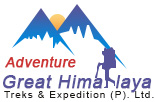
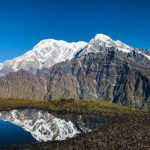 Saturday, August 30th, 2025
Saturday, August 30th, 2025
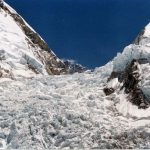 Wednesday, August 27th, 2025
Wednesday, August 27th, 2025
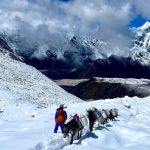 Wednesday, August 20th, 2025
Wednesday, August 20th, 2025
 Wednesday, August 20th, 2025
Wednesday, August 20th, 2025
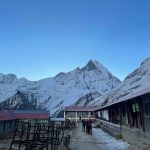 Wednesday, August 13th, 2025
Wednesday, August 13th, 2025
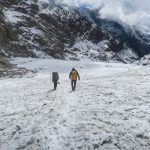 Wednesday, August 6th, 2025
Wednesday, August 6th, 2025
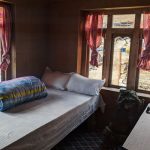 Monday, July 7th, 2025
Monday, July 7th, 2025
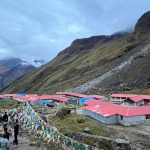 Thursday, July 17th, 2025
Thursday, July 17th, 2025
 Monday, July 7th, 2025
Monday, July 7th, 2025
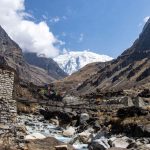 Friday, May 9th, 2025
Friday, May 9th, 2025
 Saturday, June 14th, 2025
Saturday, June 14th, 2025
 Wednesday, June 25th, 2025
Wednesday, June 25th, 2025
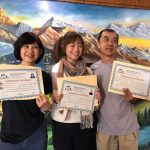 Tuesday, August 5th, 2025
Tuesday, August 5th, 2025
